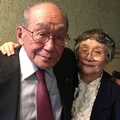The 46th elementary school opening early next year in Chula Vista with a 47.5 million dollar budget will bear Saburo Muraoka’s name. I thought the case might be the first public school built in honor of a Japanese American immigrant, unprecedented for Japanese Americans.
I looked up the late Hawaiian war hero, 442nd combat vet, U.S. Senator Daniel Inouye (1924–2012), the first Japanese American Congressman. Yes, DKI Institute was built in 2013, inside the University of Hawaii, Manoa Campus to honor his legacy. The Institute will support middle and high school STEM (science, technology, engineering, and math) and civic programs to inspire the next generation of leaders.
Another Hawaiian hero is astronaut Ellison S. Onizuka. His name is on the International Astronomy Visitor Information Center on Maunakea, and is on Onizuka Street in Little Tokyo, Los Angeles, with a scale replica of the Challenger as a memorial. Also, his name appears on the street surrounding Whitcomb Elementary School in Clear Lake City, Houston, TX, where Onizuka’s daughter attended.
Inouye and Onizuka should be an exceptional example! Could there be any comparable state or local story counterpart? I concentrated in California. Yes, what about Kanae Nagasawa (1875–1934), not as widely known now but he was once known as the Grape King in Santa Rosa? His name was referred to by former President Ronald Reagan as he spoke on Japan–U.S. relations.
Well, my finding is that his name is on the 33-acre Nagasawa Community Park on the Fountaingrove Lake, City of Santa Rosa, Sonoma County. However, it’s probable Nagasawa’s name may bear one of Sonoma County public schools in years to come. Who could deny it? He was originally a Satsuma (Kagoshima) clan student sent to Britain, then taken to California via New York, culminating successfully as a viticulturist.
Saburo Muraoka, was born in Yokohama in 1900 when his father Fukutaro was in San Diego gaining foothold both in fish related and farming businesses. Fukutaro was credited with starting farming of winter celery in Chula Vista. Saburo joined his father there in 1915 and succeeded with a celery production method with a “tents” or “caps” concept first used in Chula Vista.
I brought back a little booklet from San Diego titled “The Japanese in San Diego before the War,” written by Donald H. Estes, published by the San Diego Historical Society courtesy of Sumitomo Bank of California in 1978. Don wrote: “Saburo Muraoka, a younger Issei, had bought twenty acres of land and was growing celery and cucumbers. In the process he introduced a method of increasing the productivity of cucumbers by planting them on a ridged slope and covering them with a tent. The technique was soon in wide use throughout the South Bay.”
The Muraokas were sent to Crystal City, Texas detention camp during World War II, losing their American dream, land, and everything, eventually thinking they had to go back to Japan. However, after returning to Chula Vista, they vigorously resumed farming, not only to again grow celery and cucumbers that would be shipped nationwide, but to plant the seeds of change. Their resilience to bounce back is laudable.
One of the business seeds he planted was Mobil home park. After turning 50, Saburo sold the farmlands and became a real estate developer. The project first put a tremendous strain on the family’s finances while the park got off the ground and filled with tenants.
As the business stabilized he became involved in community activities including San Diego–Yokohama Sister City Society, Buddhist Temple, and others. I remember I sent him an invitation to attend the opening ceremony of Minato Gakuen in San Diego and I saw him on the panorama photo of the opening commemoration. Later, I sent him an invitation to the field day of Minato Gakuen and he responded by sitting with other participants on the field with his grandson. No photo exists of the event, but I can visualize their presence as if it were only yesterday.
Saburo Muraoka Elementary School! Sounds great and awesome. His name will surely be remembered forever, right along with the footprints of all Japanese Americans who settled in Southern California and San Diego and inspiring future Japanese American children. Cheers, everyone!
* This article was originally published on the author's blog “Rilsloggers” on June 12, 2016.
© 2016 Rio Imamura







